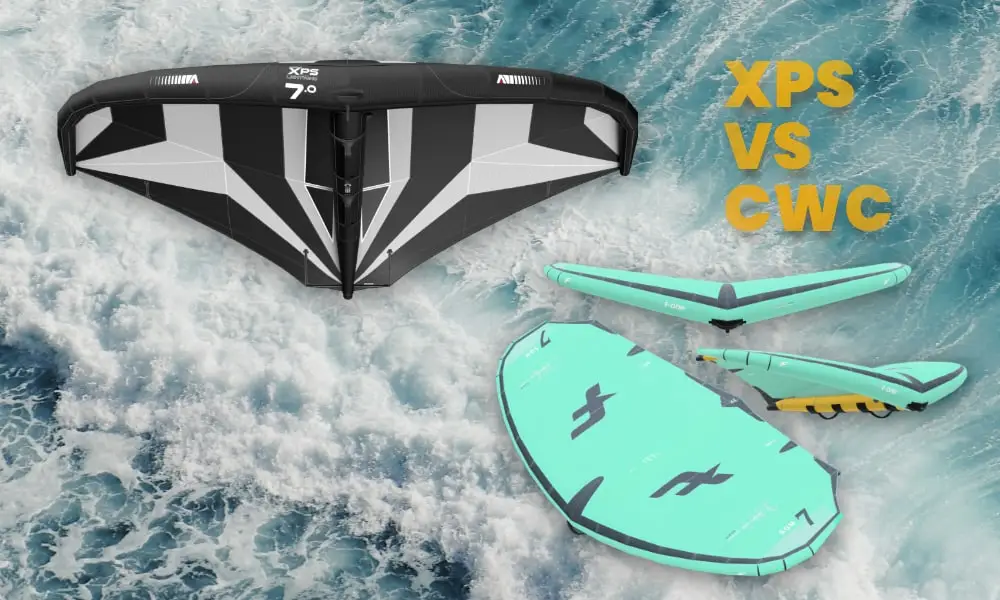Blog
Armstrong XPS VS F-One Strike CWC V4 8m Aluula

Light Wind Wing Foiling: A Comprehensive Comparison of Armstrong XPS 8m and F-One Strike CWC V4 8m Aluula
As wing foiling continues to evolve, the demand for specialized gear suited for light wind conditions has surged. In this blog, we’ll delve into a detailed comparison of two leading light wind wings: the Armstrong XPS 8m and the F-One Strike CWC V4 8m Aluula. Both wings have distinct features that cater to different styles and preferences, making it essential for riders to understand their options. This article will explore their designs, performance characteristics, and ideal setups for maximizing your light wind foiling experience.
Understanding Light Wind Wing Foiling
Light wind wing foiling presents unique challenges and opportunities for riders. When the wind speed drops to 6-10 knots, having the right wing can make all the difference. Light wind wings are designed to provide maximum lift and stability, allowing riders to get up on foil even in barely breezy conditions. Understanding the nuances of each wing’s design and performance can significantly enhance your overall experience.
Armstrong XPS 8m Wing: Power and Performance
The Armstrong XPS 8m is engineered for performance and power. This wing features a unique power batting at the strut’s end, which optimizes lift and responsiveness. The design minimizes the risk of catching on water or ground, ensuring a smooth ride even in challenging conditions. Let’s break down some of its key characteristics:
- Powerful Lift: The XPS 8m provides significant power, allowing advanced riders to tackle waves and maintain speed.
- Responsive Handling: This wing is designed for quick responsiveness, making it ideal for experienced riders who want to push their limits.
- Stability: While powerful, the XPS also offers stability, crucial for maintaining control in lighter winds.
F-One Strike CWC V4 8m Aluula: Forgiving and User-Friendly
The F-One Strike CWC V4 8m Aluula takes a different approach, focusing on user-friendliness and forgiveness. This wing features a compact design with three struts made from Aluula material, which is lightweight yet durable. Here are the standout features of the F-One Strike:
- Forgiving Design: The Strike is known for its forgiving nature, making it an excellent choice for beginners. It auto-corrects minor mistakes, allowing riders to maintain stability.
- Easy Handling: The softer handles make it easier to maneuver, especially for those just starting.
- Versatile Performance: While it is user-friendly, it can still perform well in various conditions, making it a versatile addition to any quiver.
Comparing the Two Wings
When comparing the Armstrong XPS and the F-One Strike, several factors come into play:
Power vs. Forgiveness
The Armstrong XPS is all about power and performance, making it suitable for advanced riders who want to maximize their speed and control. In contrast, the F-One Strike offers a more forgiving experience, ideal for beginners who are still mastering their skills.
Handling and Responsiveness
Riders will find that the XPS reacts quickly to input, allowing for sharp turns and aggressive maneuvers. On the other hand, the F-One Strike’s design provides a smoother, more stable ride, helping newer riders to build their confidence.
Ideal Conditions
The Armstrong XPS excels in light wind conditions where power is essential. It allows experienced riders to enjoy their time on the water, even in challenging conditions. The F-One Strike, however, is perfect for riders who may not have the experience or skill to handle more responsive gear, making it a great choice for casual outings.
Choosing the Right Setup
In addition to selecting the right wing, the board and foil setup plays a crucial role in performance. For light wind foiling, choosing the right combination can enhance your experience significantly.
Board Selection
For light wind conditions, a longer and narrower board is often recommended. This design allows for better stability and easier pumping, which is essential when trying to get up on foil with minimal wind.
Foil and Tail Wing
Your foil setup should complement your wing choice. Many riders opt for high aspect foils to maximize lift and speed. Tail wings should be chosen based on desired performance, with options ranging from speed-oriented to more maneuverable designs.
Mastering Light Wind Conditions
Light wind days can be disheartening for many riders, but with the right gear and techniques, you can make the most of these conditions. Here are some tips to enhance your light wind foiling experience:
- Start in Optimal Wind Speeds: Begin with wind speeds around 8 knots to gain confidence before venturing into lighter conditions.
- Focus on Pumping: Practice pumping both the wing and the board to build speed and get up on foil. This skill is essential for navigating super light winds.
- Utilize a Tow: If conditions are extremely light, consider using a tow to get out on the water and practice pumping.
Conclusion: Finding Your Perfect Wing
In light wind wing foiling, having the right equipment is crucial. Both the Armstrong XPS 8m and the F-One Strike CWC V4 8m Aluula offer distinct advantages and cater to different skill levels and riding styles. Whether you prioritize power and performance or forgiveness and ease of use, understanding the nuances of each wing will help you make the best choice for your needs.
As you explore the possibilities of light wind foiling, remember that practice and patience are key. With the right gear and a commitment to honing your skills, you can enjoy exhilarating sessions even when the winds are light.
If you like to buy the products click here for the Armstrong XPS Lightwind and here for the F-one CWC V4.
If you mention on the chat that you have read the article we’ll reward you.
